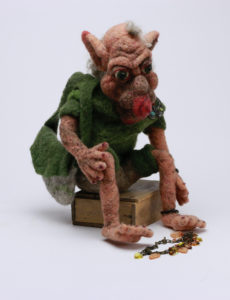Title: Homunculi Deterrent Decoy and Actual Homunculus Hoard
Class: Ficticious Artefact
Material: Decoy – Wool with Wire Armature; Hoard – miscellaneous antique household items
Origin: Scottish Highlands – Inverness area
Date: c 1855 C.E.
Attribution: Decoy – Attributed to the workshop of Helen Mary MacDonald. Hoard – Found in the rafters of a derelict croft outside of Edinborough.
Figures of this sort were likely present on the hearths of many Highland homes. These decoys were used to deter homunculi (specifically Homunculus collectus) from taking up residence based on the belief that they were very territorial. At the time when these decoys were in use, homunculi were considered by most to be unwelcome vermin. They were thought to be more of an annoyance than a major threat, although some folk believed them to be the agents of the devil. Homunculi were believed to exhibit compulsive theft and hoarding behaviour, preferring to pilfer small, frequently-used items. They were believed to prefer homes of older adults because of the lack of children’s dolls which would have deterred them . Catherine MacTavish’s journal from 1834 describes them as:
“evil wee imps who delight in making me wonder about my mind. Several times a day I search for my glasses, thimble and any number of other small items that go missing. Malcolm thought I was just being a forgetful old woman until his glasses disappeared only to be found behind the coal scuttle with my thimble and broach.”
Little is known about the belief systems associated with homunculi, likely because of the Church’s ruling that such belief was heresy and punishable by death. Despite this censure, the existence of homunculi seems to have been commonly accepted throughout Europe during the middle ages and well into the 1900s. The Church’s position likely explains why a small Bible was supplied with each decoy. Presumably its presence might have appeased religious authorities if the decoy was discovered or it might also have been thought to be frightening to a devilish homunculus .
The existence of these small human-like beings was first noted in preformationism and alchemy documents. Paracelsus (1493-1541) described a procedure for creating small humans by incubating sperm in a horse’s womb. Until recently the scientific community has dismissed claims of humunculi existence as cryptozoology. However, preliminary DNA analysis of a hair found in the displayed hoard box suggests that they do in fact exist and may be the basis of what has been a longstanding mystery as to why most cultures have mythologies of small human-like creatures (e.g. fairies, elves, brownies, leprechauns, nymphs, sprites, pixies, etc). Fitzgibert has suggested that Paracelsus inaccurately described a procedure that dates back to antiquity and that the distorted black figures in Grecian pottery are accurate portrayals of homunculi .
There is also recent evidence that a new species (Homunculus laundraphilus) has evolved in North America. Little is known about the behaviour of this new species except that its pilfering habits focus on stealing socks from washers and dryers.
